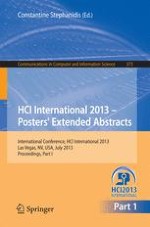This is the first of a two-volume set (CCIS 373 and CCIS 374) that constitutes the extended abstracts of the posters presented during the 15th International Conference on Human-Computer Interaction, HCII 2013, held in Las Vegas, USA, in July 2013, jointly with 12 other thematically similar conferences. The total of 1666 papers and 303 posters presented at the HCII 2013 conferences was carefully reviewed and selected from 5210 submissions. These papers address the latest research and development efforts and highlight the human aspects of design and use of computing systems. The papers accepted for presentation thoroughly cover the entire field of human-computer interaction, addressing major advances in knowledge and effective use of computers in a variety of application areas. The extended abstracts were carefully reviewed and selected for inclusion in this two-volume set. The papers included in this volume are organized in the following topical sections: HCI design approaches, methods and techniques; usability methods, techniques and studies; universal access and eInclusion; multimodal and ambient interaction; cognitive and psychological aspects of interaction; perception and interaction; ergonomic and human modelling issues; capturing gaze, biosignals and brainwaves; development environments; product design, marketing and advertisement.
